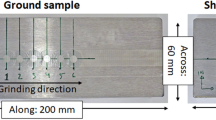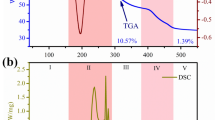Abstract
Silicon carbide–reinforced aluminum matrix composites (SiCp/Al) are widely used in aviation, automobile, electronics, and many other fields due to their excellent comprehensive material properties. However, traditional processing technology faces severe challenges. This paper proposed a novel hybrid processing method of SiCp/Al materials, photocatalytic-assisted electrochemical milling-grinding (PAECMG). In this method, the photocatalytic reaction layer on the surface of insoluble SiC particles is removed by repeated grinding. The removal mechanism of anode material SiCp/Al in the PAECMG process was studied in detail by experiments. The abrasive tool destroys the passivation layer on the workpiece’s surface to accelerate the aluminum matrix’s anodic dissolution. Moreover, the SiC-reinforced particles are repeatedly and alternately removed by photocatalytic reaction and grinding mechanical action. Microscopic surface contrast analysis demonstrated that PAECMG could simultaneously remove metal aluminum matrix and silicon carbide particles. Comparing current waveforms during machining shows that PAECMG can improve machining stability. Based on the detailed analysis of the material removal phenomenon, a qualitative model of the material removal mechanism of PAECMG was established. This study provides valuable insights into the material removal mechanism in the combined photocatalytic-assisted ECM and mechanical grinding process.




















Similar content being viewed by others
Data availability
The datasets used or analyzed during the current study are available from the corresponding author on reasonable request.
References
Samal P, Vundavilli PR, Meher A, Mahapatra MM (2020) Recent progress in aluminum metal matrix composites: a review on processing, mechanical and wear properties. J Manuf Process 59:131–152. https://doi.org/10.1016/j.jmapro.2020.09.010
Nayak KC, Deshmukh PR, Pandey AK, Vemula P, Date PP (2020) Microstructural, physical and mechanical characterization of grinding sludge based aluminium metal matrix composite. Mater Sci Eng, A 773:138895. https://doi.org/10.1016/j.msea.2019.138895
Imran M, Khan ARA (2019) Characterization of Al-7075 metal matrix composites: a review. J Market Res 8:3347–3356. https://doi.org/10.1016/j.jmrt.2017.10.012
Su Y, Ouyang Q, Zhang W, Li Z, Guo Q, Fan G, Zhang D (2014) Composite structure modeling and mechanical behavior of particle reinforced metal matrix composites. Mater Sci Eng, A 597:359–369. https://doi.org/10.1016/j.msea.2014.01.024
Guo G, Gao Q, Wang Q, Hu Y (2021) Study on meso-scale grinding surface roughness and sub-surface quality of 60% volume fraction SiCp/Al2024 composites. SILICON. https://doi.org/10.1007/s12633-021-01443-3
Gao Q, Guo G, Wang Q (2021) Study on micro-grinding mechanism and surface quality of high-volume fraction SiCp/Al composites. J Mech Sci Technol 35:2885–2894. https://doi.org/10.1007/s12206-021-0612-2
Zhou M, Wang M, Dong G (2016) Experimental investigation on rotary ultrasonic face grinding of SiCp/Al composites. Mater Manuf Processes 31:673–678. https://doi.org/10.1080/10426914.2015.1025962
Chen J, Gu L, He G (2020) A review on conventional and nonconventional machining of SiC particle-reinforced aluminium matrix composites. Advances in Manufacturing 8:279–315. https://doi.org/10.1007/s40436-020-00313-2
Marimuthu S, Dunleavey J, Liu Y, Smith B, Kiely A, Antar M (2019) Characteristics of hole formation during laser drilling of SiC reinforced aluminium metal matrix composites. J Mater Process Technol 271:554–567. https://doi.org/10.1016/j.jmatprotec.2019.04.030
Uthayakumar M, Babu KV, Kumaran ST, Kumar SS, Jappes JTW, Rajan TPD (2019) Study on the machining of Al-SiC functionally graded metal matrix composite using die-sinking EDM. Part Sci Technol 37:103–109. https://doi.org/10.1080/02726351.2017.1346020
Kendall T, Bartolo P, Gillen D, Diver C (2019) A review of physical experimental research in jet electrochemical machining. Inte J Adv Manufac Technol. https://doi.org/10.1007/s00170-019-04099-x
Chen X, Xu Z, Zhu D, Fang Z, Zhu D (2016) Experimental research on electrochemical machining of titanium alloy Ti60 for a blisk. Chin J Aeronaut 29:274–282. https://doi.org/10.1016/j.cja.2015.09.010
Hackert-Oschätzchen M, Lehnert N, Martin A, Meichsner G, Schubert A (2016) Surface characterization of particle reinforced aluminum-matrix composites finished by pulsed electrochemical machining. Procedia CIRP 45:351–354. https://doi.org/10.1016/j.procir.2016.02.078
Ao S, Qin X, Li K, Luo Z (2021) Effects of process parameters on jet electrochemical machining of SiC particle-reinforced aluminum matrix composites. Int J Adv Manufact Technol 112:3351–3361. https://doi.org/10.1007/s00170-020-06586-y
Liu Z, Gao C, Guo C, Qiu Y (2020) Simulation and experiments of abrasive assisted electrochemical jet machining of SiC reinforced aluminum matrix composites. Procedia CIRP 95:760–765. https://doi.org/10.1016/j.procir.2020.02.264
Liu Z, Gao C, Yu X, Guo C (2021) Improving machining localization in abrasive-assisted electrochemical jet machining of SiCp/Al composites using large standoff distance. Arab J Sci Eng. https://doi.org/10.1007/s13369-021-06382-0
Saxena KK, Qian J, Reynaerts D (2018) A review on process capabilities of electrochemical micromachining and its hybrid variants. Int J Mach Tools Manuf 127:28–56. https://doi.org/10.1016/j.ijmachtools.2018.01.004
Yan Q, Wang X, Xiong Q, Lu J, Liao B (2020) The influences of technological parameters on the ultraviolet photocatalytic reaction rate and photocatalytic-assisted polishing effect for SiC. J Cryst Growth 531:125379. https://doi.org/10.1016/j.jcrysgro.2019.125379
Lu J, Wang Y, Luo Q, Xu X (2017) Photocatalytic assisting the mechanical polishing of a single-crystal SiC wafer utilizing an anatase TiO2 -coated diamond abrasive. Precis Eng 49:235–242. https://doi.org/10.1016/j.precisioneng.2017.02.011
Gao B, Zhai W, Zhai Q, Zhang M (2019) Novel polystyrene/CeO2-TiO2 multicomponent core/shell abrasives for high-efficiency and high-quality photocatalytic-assisted chemical mechanical polishing of reaction-bonded silicon carbide. Appl Surf Sci 484:534–541. https://doi.org/10.1016/j.apsusc.2019.04.037
Wang M, Qu N (2021) Investigation on material removal mechanism in mechano-electrochemical milling of TC4 titanium alloy. J Mater Process Technol 295:117206. https://doi.org/10.1016/j.jmatprotec.2021.117206
Mohammad AEK, Wang D (2016) Electrochemical mechanical polishing technology: recent developments and future research and industrial needs. Int J Adv Manufact Technol 86:1909–1924. https://doi.org/10.1007/s00170-015-8119-6
Ge Y, Zhu Z, Zhu Y (2019) Electrochemical deep grinding of cast nickel-base superalloys. J Manuf Process 47:291–296. https://doi.org/10.1016/j.jmapro.2019.10.007
Shen N, Ningsong Q, Xiaokang Y, Hansong L. (2019) Effect of tool-sidewall outlet hole design on machining performance in electrochemical mill-grinding of Inconel 718. Journal of Manufacturing Processes,41. https://doi.org/10.1016/j.jmapro.2019.03.027
Ge Y, Zhu Z, Wang D, Ma Z, Zhu D (2019) Study on material removal mechanism of electrochemical deep grinding. J Mater Process Technol 271:510–519. https://doi.org/10.1016/j.jmatprotec.2019.04.033
Rahi DK, Dubey AK. (2022) Comparative study of machining quality for the Al–SiC–Gr hybrid metal matrix composite using ECM and ECSG. Proceedings of the Institution of Mechanical Engineers, Part C: Journal of Mechanical Engineering Science:634262930. https://doi.org/10.1177/09544062211069330
Kaczmarek J, Zachwieja T (1966) Investigations on the material removal rate by electrochemical grinding of cutting tool materials in dependence on the properties of the grinding wheel. International Journal of Machine Tool Design and Research 6:1–13. https://doi.org/10.1016/0020-7357(66)90002-3
Noble CF, Davies BJ (1983) Electro-mechanical action in peripheral electrochemical grinding. CIRP Ann 32:123–127. https://doi.org/10.1016/S0007-8506(07)63375-7
Deng J, Lu J, Yan Q, Zhang Q, Pan J. (2020) Preparation and polishing properties of water-based magnetorheological chemical finishing fluid with high catalytic activity for single-crystal SiC. Journal of Intelligent Material Systems and Structures:1045389X-2097550X. https://doi.org/10.1177/1045389X20975503
Funding
This research is financially supported by the National Natural Science Foundation of China (Grant no. 52075334) and the NSFC Key Project for International Collaboration (Grant no. 51961135201).
Author information
Authors and Affiliations
Contributions
Feng Wang: conceptualization, methodology, validation, formal analysis, and writing—original draft and editing. Siyi Wu: formal analysis and validation. Jing Zhou: formal analysis and validation. Xiaoming Kang: funding acquisition, supervision, and writing—reviewing and editing. Wan-Sheng Zhao: funding acquisition, supervision, and writing—reviewing and editing.
Corresponding author
Ethics declarations
Ethical approval
Not applicable.
Consent to participate
Not applicable.
Consent for publication
All authors approve the manuscript for publication.
Competing interests
The authors declare no competing interests.
Additional information
Publisher's Note
Springer Nature remains neutral with regard to jurisdictional claims in published maps and institutional affiliations.
Rights and permissions
Springer Nature or its licensor (e.g. a society or other partner) holds exclusive rights to this article under a publishing agreement with the author(s) or other rightsholder(s); author self-archiving of the accepted manuscript version of this article is solely governed by the terms of such publishing agreement and applicable law.
About this article
Cite this article
Wang, F., Zhou, J., Wu, S. et al. Study on material removal mechanism of photocatalytic-assisted electrochemical milling-grinding SiCp/Al. Int J Adv Manuf Technol 124, 817–832 (2023). https://doi.org/10.1007/s00170-022-10539-y
Received:
Accepted:
Published:
Issue Date:
DOI: https://doi.org/10.1007/s00170-022-10539-y




